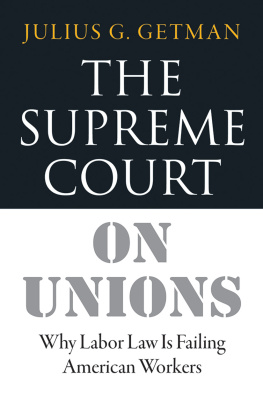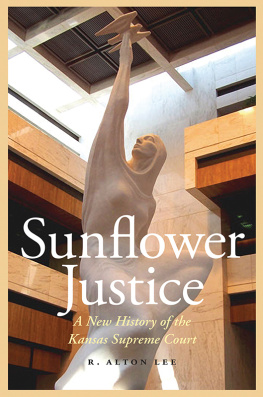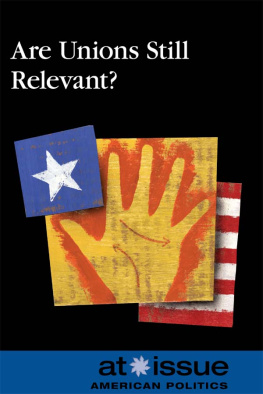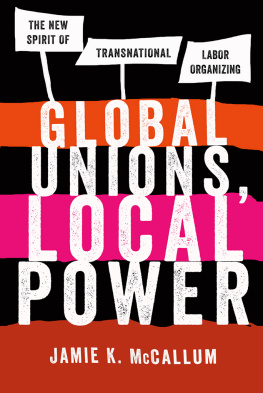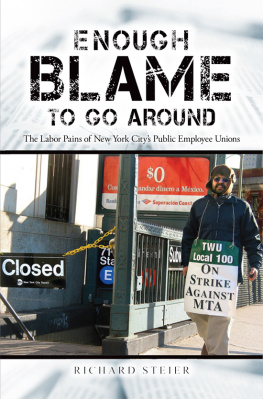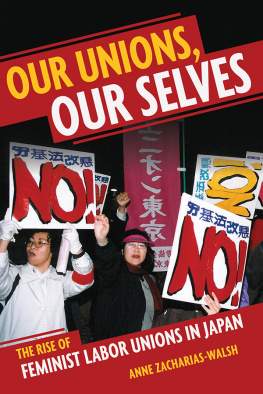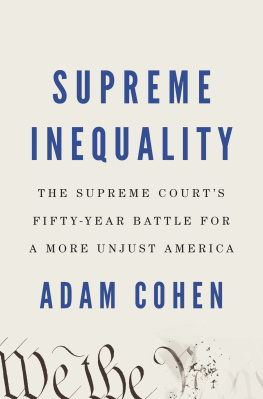THE SUPREME COURT ON UNIONS
WHY LABOR LAW IS FAILING AMERICAN WORKERS
Julius G. Getman
ILR Press
an imprint of
CORNELL UNIVERSITY PRESS
ITHACA AND LONDON
To the many students with whom I have traded ideas and from whom I have learned in fifty years of teaching and with special affection to those who are continuing to teach, write, and practice in the field
CONTENTS
PREFACE
This book is the culmination of a long transformative process that began in the late 1950s when I was a student at Harvard Law School. While there I studied labor law with the masterArchibald Cox, from whom I learned that labor law issues were often legally complex and morally ambiguous. Cox taught the course with a magisterial neutrality that drew its essence from his many years as a scholar and his work as a neutral labor arbitrator, and its focus from the language and legislative history of the National Labor Relations Act.
Shortly after law school, I began my career as a labor lawyer as a staff attorney at the National Labor Relations Board (NLRB) in Washington. I began in the Advice Section dealing with difficult cases that were sent from the Boards regional offices to Washington for disposition. Gradually I began to think of myself as an expert versed in the intricacies of doctrine and interplay of subsectionsthe special language of labor law.
When I began teaching labor law in 1963 at Indiana University School of Law in Bloomington, Archibald Cox provided the model and my NLRB experience the language by which I conveyed to students the moral ambiguity and analytic difficulties that lay hidden in labor law issues. I took pride in the thought of myself as a neutral labor law expert and was delighted when perplexed students asked me if I was prolabor or promanagement.
What changed my approach to labor law and teaching was contact with reality. It is the study of and participation in labor relations reality that has most shaped my career as a scholar and teacher.
My first significant contact with labor relations reality was the ten-year study of union organizing that I conducted with Professors Goldberg and Brett in the late sixties and early seventies. During the course of the study I interviewed employees, union organizers, management officials, lawyers, and consultants. I began to realize how different the law looked from the perspective of the workers in whose interest it was regularly justified but whose voice was seldom heard.
During the late seventies and early eighties I served as chief negotiator for the Connecticut State Police Union and played an active role in support of the union organizing campaign of Yales clerical and technical workers conducted by UNITE HERE. From 1986 to 1988 I served as national president of the American Association of University Professors, which among other things represents faculty members in collective bargaining. In the 1990s I did a major field study of the bitter strike by Local 14 of the United Paperworkers International Union (UPIU) against the International Paper Company. I interviewed permanently replaced strikers, replacement workers, company and union officials, the parish priest of Jay, Maines, largest church, and the town manager. I walked through deserted streets where half the homes had for sale signs out front. The more I learned about labor relations reality, the less persuasive I found the standard Labor Board analysis and the reasoning of the major court opinions that I taught in my labor law classes.
I finally retired in the summer of 2014 after fifty years of law teaching. I have long since given up the pose of neutrality and made clear to my students the values, assumptions, and factual conclusions that shape my analysis of labor law issues. I also make clear that I believe in the importance of unions and the value of collective bargaining. My scholarship and my participation in labor relations have taken a great toll on my youthful idealism and faith in the neutrality and expertise of federal judges and NLRB board members. In this book I seek to explain the analytic inconsistency, the repetitive bias, and the factual ignorance that have reshaped basic labor law and rendered it ineffective.
ACKNOWLEDGMENTS
I thank Terri LeClercq for her many suggestions, world-class editing, and continuing moral support; also for the benefit of our twenty-five-year discussion of the elements of good writing. Thanks also to Marsha Moyer, novelist and faculty assistant, for editing, typing, and perceptive criticism of the early drafts of the manuscript. Special thanks to my colleague and friend Professor Richard Markovits, who provided constant encouragement and significant editorial help. Thanks to my student assistant Tyler Somes for his great help with the form and substance of the footnotes; to Professor Justin Driver of the University of Chicago Law School for enjoyable discussion that led me to select the topic; to Fran Benson of Cornell University Press for encouraging me to write this book; and to the anonymous reviewers of the manuscript for their many useful suggestions. I also thank Susan Specter, the production editor, for capably shepherding the project, and Jamie Fuller for her careful copyediting.
INTRODUCTION
Labor unions and courts have rarely been allies. From their earliest efforts to organize, unions have been confronted with hostile judges and antiunion doctrines. In the early 1800s, when labor law was developed primarily by state courts, union activity and unions themselves were often declared to be criminal conspiracies to distort the market. It wasnt until 1842 that the conspiracy doctrine was effectively challenged by Lemuel Shaw, a highly regarded member of the Supreme Judicial Court of Massachusetts, in the case of Commonwealth v. Hunt .
Shaws analysis pretty much ended the conspiracy doctrine, but it did not usher in an era of mutual accommodation between unions and courts. In the aftermath of the Hunt case, courts shifted from holding unions illegal by virtue of their antimarket goals to finding many of their activities, particularly strikes and boycotts, unlawful. As noted by Frankfurter and Greene in their classic book The Labor Injunction , courts were quick to find a variety of union goals and tactics unlawful. Courts regularly found unions guilty of violence or illegal coercion when their conduct involved nothing more than peaceful picketing or demonstrations. One court announced that there is and can be no such thing as peaceful picketing, any more than there can be chaste vulgarity, or peaceful mobbing, or lawful lynching. Findings of violence or other union impropriety
The Supreme Court was a minor player in labor relations until the last decade of the nineteenth century. But once it began to address labor relations issues, it did so by firmly supporting the traditional rights of employers. One of the Courts first important labor decisions was In re Debs , in which it affirmed the right of a federal court to broadly enjoin a railroad strike and imprison those whom it found to have disobeyed its order. The case grew out of a strike called by the American Railroad Union led by Eugene V. Debs to protest a 25 percent wage cut.
Soon after the strike began, a federal judge ordered the defendants and all persons combining and conspiring with them, and all other persons whomsoever, absolutely to desist and refrain from in any way or manner interfering with, hindering, obstructing, or stopping any of the business of any of a list of railroads. Debs and four other union leaders were arrested and imprisoned on grounds that they violated the injunction. Speaking for a unanimous Court, Justice Brewer stressed the right of federal courts to issue injunctions when federal interests (in this case in the transportation of mail) were threatened. Indeed, it is more to the praise than to the blame of the government that, instead of determining for itself questions of right and wrong and enforcing that determination by the club of the policeman and the bayonet of the soldier, it submitted all those questions to the peaceful determination of judicial tribunals and invoked their consideration and judgment as to the measure.

